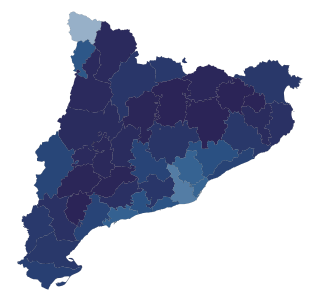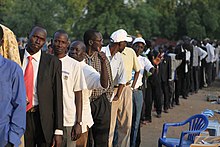
The right of a people to self-determination is a cardinal principle in modern international law, binding, as such, on the United Nations as authoritative interpretation of the Charter's norms. It states that peoples, based on respect for the principle of equal rights and fair equality of opportunity, have the right to freely choose their sovereignty and international political status with no interference.

Independence is a condition of a nation, country, or state, in which residents and population, or some portion thereof, exercise self-government, and usually sovereignty, over its territory. The opposite of independence is the status of a dependent territory or colony. The commemoration of the independence day of a country or nation celebrates when a country is free from all forms of colonialism; free to build a country or nation without any interference from other nations.
Secession is the formal withdrawal of a group from a political entity. The process begins once a group proclaims an act of secession. A secession attempt might be violent or peaceful, but the goal is the creation of a new state or entity independent of the group or territory from which it seceded. Threats of secession can be a strategy for achieving more limited goals.

The Quebec sovereignty movement is a political movement whose objective is to achieve the independence of Quebec from Canada. Sovereignists suggest that the people of Quebec make use of their right to self-determination – a principle that includes the possibility of choosing between integration with a third state, political association with another state or independence – so that Québécois, collectively and by democratic means, give themselves a sovereign state with its own independent constitution.

The 1995 Quebec referendum was the second referendum to ask voters in the predominantly French-speaking Canadian province of Quebec whether Quebec should proclaim sovereignty and become an independent country, with the condition precedent of offering a political and economic agreement to Canada.
The Clarity Act is legislation passed by the Parliament of Canada that established the conditions under which the Government of Canada would enter into negotiations that might lead to secession following such a vote by one of the provinces. The Clarity Bill (C-20) was tabled for first reading in the House of Commons on 13 December 1999. It was passed by the House on 15 March 2000, and by the Senate, in its final version, on 29 June 2000.
Presented below is a list of lists of active separatist movements:
The 1980 Quebec independence referendum was the first referendum in Quebec on the place of Quebec within Canada and whether Quebec should pursue a path toward sovereignty. The referendum was called by Quebec's Parti Québécois (PQ) government, which advocated secession from Canada.

Reference Re Secession of Quebec, [1998] 2 SCR 217 is a landmark judgment of the Supreme Court of Canada regarding the legality, under both Canadian and international law, of a unilateral secession of Quebec from Canada.
There have been various movements within Canada for secession.

The Catalan independence movement is a social and political movement which seeks the independence of Catalonia from Spain.

On 17 February 2008, the majority of members of the Assembly of Kosovo, including Hashim Thaçi, and Fatmir Sejdiu, not acting in the capacity of PISG, declared Kosovo an independent and sovereign state. Kosovo was soon recognized as a sovereign state by the United States, Turkey, Albania, Austria, Germany, Italy, France, the United Kingdom, the Republic of China (Taiwan), and others. This triggered an international debate over whether Kosovo's unilateral declaration of independence had set a precedent in international law that could apply to other separatist movements, or whether it is a special case. The recognition of Kosovo's independence by 101 out of 193 UN states, according to many sources, has given fresh impetus to other separatist movements.

In the context of the United States, secession primarily refers to the voluntary withdrawal of one or more states from the Union that constitutes the United States; but may loosely refer to leaving a state or territory to form a separate territory or new state, or to the severing of an area from a city or county within a state. Advocates for secession are called disunionists by their contemporaries in various historical documents.

An independence referendum was held in the Armenia SSR on 21 September 1991 to determine whether to secede from the Soviet Union. It followed a declaration of independence on 23 August 1990. 99.5% of voters voted in favour, with a turnout of 95%. The country officially became an independent state on 23 September 1991.

A non-binding Catalan self-determination referendum, also known as the Citizen Participation Process on the Political Future of Catalonia, was held on Sunday, 9 November 2014, to gauge support on the political future of Catalonia. While also referred to as "Catalan independence referendum", the vote was rebranded as a "participation process" by the Government of Catalonia, after a "non-referendum popular consultation" on the same topic and for the same date had been suspended by the Constitutional Court of Spain.
A sovereignty referendum was held in Tatarstan, Russia, on 21 March 1992. Voters were asked whether they approved of Tatarstan being a sovereign state.
As a result of the advisory 2017 Catalan independence referendum, reactions came from a multitude of avenues, including the domestic central state and other official bodies, as well as international commentary. Whilst the government and non-government community in Catalonia defended the vote, most of the international community either defended Spain's "territorial integrity" or simply criticised the central police's overhanded response. Other sub-national entities also supported Catalonia.

The Catalan declaration of independence was a resolution that was passed by the Parliament of Catalonia on 27 October 2017. While the text proclaims the independence of Catalonia from Spain and the establishment of an independent Catalan Republic, the declaration itself did not receive recognition from the international community and it produced no legal effect.

A non-binding independence referendum was held in Bougainville, an autonomous region of Papua New Guinea, between 23 November and 7 December 2019. The referendum question was a choice between greater autonomy within Papua New Guinea and full independence; voters voted overwhelmingly (98.31%) for independence.















